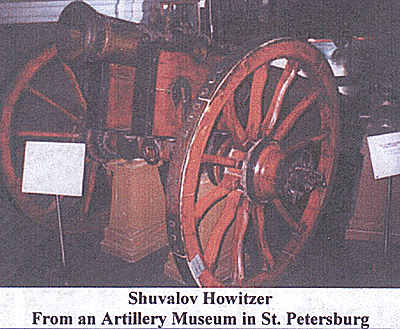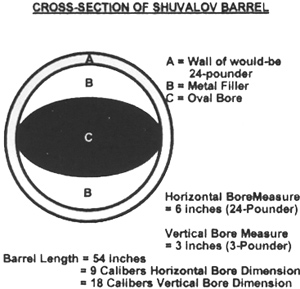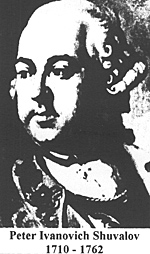 The Shuvalov "secret howitzer" suffers a reputation for poor mobility. Carpenter calls it "an extremely heavy piece, ponderous and difficult in the extreme to maneuver." This is attributed to the effect to conceal the oval shape of its bore by surrounding it with a conventionally cylindrical exterior barrel, thereby burdening the piece with "a tremendous amount of superfluous metal... much more metal than a 24-pounder of the same barrel length," as per the following diagram:
The Shuvalov "secret howitzer" suffers a reputation for poor mobility. Carpenter calls it "an extremely heavy piece, ponderous and difficult in the extreme to maneuver." This is attributed to the effect to conceal the oval shape of its bore by surrounding it with a conventionally cylindrical exterior barrel, thereby burdening the piece with "a tremendous amount of superfluous metal... much more metal than a 24-pounder of the same barrel length," as per the following diagram:
Maddeningly, there is to be found in the usual sources no figure for the Shuvalov's actual weight, even where such figures are reported for other artillery pieces. Neither are we told just what fraction of that weight was contributed by the metal filler needed to compress an otherwise 6-inch diameter cylinder into an oval barrel interior half as voluminous (that is, 54 x [3 squared] x pi cubic inches vs. 54 x 3 x 1.5 x pi cubic inches).
Can these weights be estimated?
If one cubic foot (= 1,728 cubic inches) of bronze weighs 550 pounds, then one-half a cylindrical barrel-interior-full thereof for a 6-inch, 9-calibers-long gun equals ((1/2 x 54 x [3 squared] X pi)/1728) x 550 pounds or 243 pounds, which is to say that the filler added one horse to the team otherwise required for a 9-caliber 24-pounder.
 Duffy (Russia's Military Way to the West) reports the barrel weight for the more robust version of the 1-pud "Unicorn" artillery piece to have been 139 puds, which equates to 5,000 pounds at 36 pounds to the pud. Applying to this case the barrel weight in proportion to throw weight rule (for pieces of like design family) would yield a barrel weight for the 1/4-pud Unicorn of 1,250 pounds. And given the unicorn family's characteristic barrel-length-to-bore ratio of 10 calibers, and considering that pieces of throw-weights '/4-pud stone, 9 pounds stone, and 24 pounds iron have all the same 6-inch bore, this should make the barrel weight excluding filler for the 9-calibers-long Shuvalov very nearly equivalent to that for the 1/4-pud unicorn.
Duffy (Russia's Military Way to the West) reports the barrel weight for the more robust version of the 1-pud "Unicorn" artillery piece to have been 139 puds, which equates to 5,000 pounds at 36 pounds to the pud. Applying to this case the barrel weight in proportion to throw weight rule (for pieces of like design family) would yield a barrel weight for the 1/4-pud Unicorn of 1,250 pounds. And given the unicorn family's characteristic barrel-length-to-bore ratio of 10 calibers, and considering that pieces of throw-weights '/4-pud stone, 9 pounds stone, and 24 pounds iron have all the same 6-inch bore, this should make the barrel weight excluding filler for the 9-calibers-long Shuvalov very nearly equivalent to that for the 1/4-pud unicorn.
Therefore, we may decide that the Shuvalov "secret howitzer" probably weighed about 1,500 pounds (1,250 + 243 filler), and so required six horses to draw, of which one was needed for the weight of filler.
What can account, then, for the Shuvalov's reputation for extreme cumbersomeness? After all, at 1,500 pounds it would have weighed no more than a 22-caliber 6-pounder gun like the "heavy Dieskau," and considerably less than a 16-18 calibers-long "Austrian" 12-pounder gun of 1,800-2,000 pounds, both of which pieces were as maneuverable - as they needed to be. My guess is that it results not from the Shuvalov's weight per se, but from its employment as an infantry heavy weapon, in which role it would be regarded as very heavy indeed by comparison with the 3-pounder battalion guns which it supplanted. The Shuvalov was better employed with the positional artillery, where its unique canister spray pattern might well suit it for close-in defense for the longer ranged guns against enemy cavalry and infantry attacks.
 The Shuvalov's real problem was one of "bang for the buck" - that is, its operating cost denominated in horses required to haul relative to that, say, of the 1/4-pud unicorn, which would result in a given number of horses supporting only 5/6 as many of the former as the latter, and this with the latter having twice the throw-weight per discharge per piece. Accordingly, in the absence of any advantage in rate of fire, the advantage conferred by the Shuvalov's oval bore must have been perceived to be very great, if the diversion of scarce horseflesh thereto were to appear justified.
The Shuvalov's real problem was one of "bang for the buck" - that is, its operating cost denominated in horses required to haul relative to that, say, of the 1/4-pud unicorn, which would result in a given number of horses supporting only 5/6 as many of the former as the latter, and this with the latter having twice the throw-weight per discharge per piece. Accordingly, in the absence of any advantage in rate of fire, the advantage conferred by the Shuvalov's oval bore must have been perceived to be very great, if the diversion of scarce horseflesh thereto were to appear justified.
Sources
Carpenter, "Russian Artillery in the Seven Years War," SYWAJ, Vol. X, No. 2.
Duffy, Russia's Military Way to the West.
Back to Seven Years War Asso. Journal Vol. XIII No. 1 Table of Contents
Back to Seven Years War Asso. Journal List of Issues
Back to Master Magazine List
© Copyright 2003 by James J. Mitchell
This article appears in MagWeb.com (Magazine Web) on the Internet World Wide Web.
Other articles from military history and related magazines are available at http://www.magweb.com